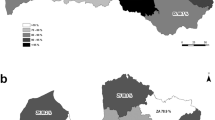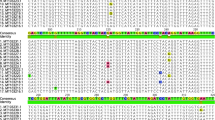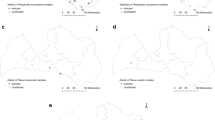Abstract
In the last 15 years, the mesocercariae of Alaria alata have frequently been reported in the wild boar during routine Trichinella inspections made compulsory for the trade of venison meat in Europe. If these studies have focused primarily on mesocercariae isolated from meat, few works have been done so far to understand the circulation of the parasite in natural conditions especially in the intermediate hosts. This study focuses on the second intermediate hosts of this parasite assessing the suitability of two amphibian groups—brown frogs and water frogs sensu lato—for mesocercarial infection on an area where A. alata has already been identified in water snails and wild boars. During this study, both groups showed to be suitable for mesocercarial infection, with high prevalence and parasite burdens. Prevalence was higher in the brown frog group (56.9 versus 11.54 % for water frogs) which would indicate that it is a preferential group for infection on the study area, though reasons for this remain to be investigated. No significant difference among prevalences was observed between tadpoles and frogs. This study, the first focusing on A. alata in these amphibians in Europe, provides further information on circulation of this parasite in natura.


Similar content being viewed by others
References
Andreas K (2006). Helminthen einheimischer Froschlurche. Vet Diss Berlin. Journal-Nr3048
Al-Sabi MN, Chriél M, Jensen TH, Enemark HL (2013) Endoparasites of the raccoon dog (Nyctereutes procyonoides) and the red fox (Vulpes vulpes) in Denmark 2009–2012—a comparative study. Int J Parasitol: Parasites and Wildlife 2:144–151
Augert D, Joly P (1993) Plasticity of age at maturity between two neighboring populations of the common frog (R. temporaria L.). Can J Zool 71:26–33
Balint N, Citrea L, Memetea A, Jurj N, Condure N (2008) Feeding Ecology of the Pelophylax ridibundus (Anura, Ranidae) in Dobromir. Romania Biharean Biol 2:27–37
Baermann G (1917) Eine einfache Methode zur Auffindung vor Ankylostomum (Nemato- den) Larven in Erdproben. Meded. Geneesk Laborat. Weltever Feestbundel p. 41
Beaver PC, Little MD, Tucker CF, Reed RJ (1977) Mesocercaria in the skin of man in Louisiana. Am J Trop Med Hyg 26(3):422–426
Berger L (1973) Systematics and hybridization in European green frogs of Rana esculenta complex. J of Herpetol 7(1):1–10
Berger L (1988) Principles of studies of European water frogs. Acta Zool Cracov 31:563–580
Bosma NJ (1931) Alaria mustelae sp. nov., a trematode requiring four hosts. Science 74:521–522
Brumpt E (1945) Présence en Corse d’Alaria tetracystis chez la Couleuvre à collier (Tropidonotus natrix) et cyle évolutif probable de ce parasite. Ann Parasitol Hum Comp 20(34):118–124
Castro O, Venzal JM, Félix ML (2009) Two new records of helminth parasites of domestic cat from Uruguay: Alaria alata (Goeze, 1782) (Digenea, Diplostomidae) and Lagochilascaris major Leiper, 1910 (Nematoda, Ascarididae). Vet Parasitol 160:322–347
Cirovic D, Pavlovic I, Penezic A, Kulisic Z, Selakovic S (2015) Levels of infection of intestinal helminth species in the golden jackal Canis aureus from Serbia. J Helminthol 89:28–33
Crawley MJ (2007) The R book. John Wiley & Sons Ltd, 949
Crump ML (1983) Opportunistic cannibalism by amphibian larvae in temporary aquatic environments. Am Nat 121:281–289
Dollfus RP, Chabaud AG (1953) Distomum musculorum suis H.C. Duncker 1896, mesocercaire d’Alaria alata (J.A.E. Goeze, 1782), (trematode, Strigeata) chez un sanglier (Sus scrofa L. 1758, Fera). Ann Parasitol Hum Comp 28(5–6):354–364
Dubois G (1968) Synopsis des strigeidae et des Diplostomatidae (Trematoda). Mémoire de la société neufchateloise des sciences naturelles Tome 10, premier fascicule, 258 pp
Duguet R, Melki F (2003) Les Amphibiens de France, Belgique et Luxembourg. Collection Parthénope, éditions Biotope, Mèze (France), 480
Duncker HCJ (1896) Die Muskeldistomeen. Berliner Thierärztliche Wochenschrift 24:279–282
Elmberg J (1991) Ovarian cyclicity and fecundity in boreal common frogs Rana temporaria along a climatic gradient. Funct Ecol 5:340–350
Fernandes BJ, Cooper JD, Cullen JB, Freeman RS, Ritchie AC, Scott AA, Stuart PF (1976) Systemic infection with Alaria americana (Trematoda). Can Med Assoc J 115(11):1111–1114
Freeman RS, Stuart PF, Cullen SJ, Ritchie AC, Mildon A, Fernandes BJ, Bonin R (1976) Fatal human infection with mesocercariae of the trematode Alaria americana. Am J Trop Med Hyg 25(6):803–807
Fried B, Abruzzi A (2010) Food-borne trematode infections of humans in the United States of America. Parasitol Res 106(6):1263–1280
Gasc JP, Cabela A, Crnobrnja-Isailovic J, Dolmen D, Grossenbacher K, Haffner P, Lescure J, Martens H, Martinez Rica JP, Maurin H, Oliveira ME, Sofianidou TS, Veith M, Zuiderwijk A (eds) (1997) Atlas of amphibians and reptiles in Europe. Collection Patrimoines Naturels, 29. Societas Europea Herpetologica & Museum National d’Histoire Naturelle (IEGB/SPN), Paris
Gastaldi B (1854) Cenni sopra alcuni nuovi Elminti della Rana esculenta con nuove osservatione sul Codonocephalus mutabilis (Diesing). Tesi per aggregazione al Collegio della Facolta delle Scienze Fisiche e Mathematiche nella R Univ di Torino: 25–36
González-Fuentes H, Hamedy A, von Borell E, Luecker E, Riehn K (2014a) Tenacity of Alaria alata mesocercariae in homemade German meat products. Int J Food Microbiol 176:9–14
González-Fuentes H, Riehn K, Koethe M, von Borell E, Luecker E, Hamedy A (2014b) Effects of in vitro conditions on the survival of Alaria alata mesocercariae. Parasitol Res 113(8):2983–2989
González-Fuentes H, Hamedy A, Koethe M, von Borell E, Luecker E, Riehn K (2015) Effect of temperature on the survival of Alaria alata mesocercariae. Parasitol Res doi:. doi:10.1007/s00436-014-4301-2
Graf JD, Polls Pelaz M (1989) Evolutionary genetics of Rana esculenta complex. Evolution and Ecology of Unisexual Vertebrates (Dawley RM., Bogart JP, eds), 289–302
Griffiths (1997) Temporary ponds as amphibian habitats. Aquat Conserv 7:119–126
Haapanen A (1982) Breeding of the common frog (Rana temporaria L.). Ann. Zool. Fennici 19:75–79
Hofer DP, Johnson AD (1970) Alaria mustelae, A. marcianae, and A. arisaemoides: chemical nature of mesocercarial capsule. Trans Am Microsc Soc 89:254–259
Holsbeek G, Mergeay J, Hotz H, Plötner J, Volckaert FAM, De Meester L (2008) A cryptic invasion within an invasion and widespread introgression in the European water frog complex: consequences of uncontrolled commercial trade and weak international legislation. Mol Ecol 17:5023–5035
Hotz H, Semlitsch RD, Gutmann E, Guex GD, Beerli P (1999) Spontaneous heterosis in larval life-history traits of hemiclonal frog hybrids. PNAS USA 96:2171–2176
Johnson AD (1968) Life history of Alaria marcianae (La Rue, 1917) Walton, 1949 (Trematoda: Diplostomatidae). J Parasitol 54(2):324–332
Kwet A (1996) Predators of anuran eggs. Salamandra 32:31–44
Lesbarrères D, Lodé T (2002) Influence de facteurs environnementaux sur la reproduction de Rana dalmatina (Anura, Ranidae): implications pour sa conservation. Bull Soc Herp Fr 104:62–71
Lester RJ, Freeman RS (1975) Penetration of vertebrate eyes by cercariae of Alaria marcianae. Can J Public Health 66(5):384–387
Leuckart R (1896–1901) Die Parasiten des Menschen und die von ihnen herrührenden Krankheiten. Leipzig und Heidelberg: C. F. Winteŕsche Verlagshandlung
Li W, Guo Z, Duo H, Fu Y, Peng M, Shen X, Tsukada H, Irie T, Nasu T, Horii Y, Nonaka N (2013) Survey on helminths in the small intestine of wild foxes in Qinghai, China. J Vet Med Sci 75:1329–1333
Lukijanov SV, Ruchin AB, Chikhljaev IV, Ryzhov MK (2008) The helminthofauna of the Moor Frog Rana arvalis (Amphibia: Anura) in Mordovia (Vol. 2, pp. 149–151). Presented at the IV congress of the Russian Society of parasitologists, Russian academy of Sciences
McDonald HR, Kazacos KR, Schatz H, Johnson RN (1994) Two cases of intraocular infection with Alaria mesocercaria (Trematoda). Am J Ophthalmol 117(4):447–455
Miaud C, Guyetant R, Elmberg J (1999) Variations in life-history traits in the common frog (R. temporaria, Amphibia: Anura): a literature review and new data from the French Alps. J Zool (Lond) 249:61–73
Miaud C, Muratet J (2004) Identifier les oeufs et les larves des amphibiens de France. INRA Editions, Paris, 200
Milesevic M, Ekert M, Mahnik M (2004) [Incidence of mesocercaria of Alaria alata in the meat of wild boars killed in the hunting grounds “Povavske sume” from 4 September to 10 December 2003]. In Russia. Veterinarska Stanica 35(4): 215–219
Möhl K, Grosse K, Hamedy A, Wuste T, Kabelitz P, Lucker E (2009) Biology of Alaria spp. and human exposition risk to Alaria mesocercariae-a review. Parasitol Res 105(1):1–15
Moks E, Jogisalu I, Saarma U, Talvik H, Jarvis T, Valdmann H (2006) Helminthologic survey of the wolf (Canis lupus) in Estonia, with an emphasis on Echinococcus granulosus. J Wildl Dis 42(2):359–365
Muratet J (2007) Identifier les amphibiens de France métropolitaine: Guide de terrain. Association Ecodiv Eds, France, 291p
Murphy TM, O’Connell J, Berzano M, Dold C, Keegan LD, McCann A, Murphy D, Holden NM (2012) The prevalence and distribution of Alaria alata, a potential zoonotic parasite, in foxes in Ireland. Parasitol Res 111:283–290
Neveu A (2004) La raniculture est-elle une alternative à la récolte? Etat actuel en France INRA Prod Anim 17:167–175
Nikitina EN (1986) Trematode larvae in snails of Lake Glubukoe. Hydrobiologia 141:139–141
Odening K (1963) Zur diagnostik des Mesocercarie von Alaria alata, eines möglichen Parasiten des Menschen in Europa, an Hand experimenteller Befunde beim Affen. Mber Dtsch Akad Wiss Berlin 5:385–390
Pagano A, Crochet PA, Graf JD, Joly P, Lode T (2001) Distribution and habitat use of water frog hybrid complexes in France. Global Ecol Biogeogr 10:433–441
Pagano A, Dubois A, Lesbarrères D, Lodé T (2003) Frog alien species: a way for genetic invasion? CRAS 326:85–92
Patrelle C, Torsten O, Picard D, Pagano A, Sourice S, Dallay MG, Plötner J (2011) A new PCR-RFLP-based method for an easier systematic affiliation of European water frogs. Mol Ecol Res 11:200–205
Paulsen P, Ehebruster J, Irschik I, Lücker E, Riehn K, Winkelmayer R, Smulders FJM (2012) Findings of Alaria alata mesocercariae in wild boars (Sus scrofa) in eastern Austria. Eur J Wildl Res 58:991–995
Paulsen P, Forejtek P, Hutarova Z, Vodnansky M (2013) Alaria alata mesocercariae in wild boar (Sus scrofa, Linnaeus, 1758) in south regions of the Czech Republic. Vet Parasitol 197(1–2):384–387
Pearson JC (1956) Studies of the life cycles and morphology of the larval stages of Alaria arisaemoides (Augustine and Uribe, 1927) and Alaria canis (LaRue and Fallis, 1936) (Trematoda: Diplostomatidae). Can J Zool 34:295–387
Pearson JC (1959) Observations on the morphology and life cycle of Strigea elegans Chandler & Rausch, 1947 (Trematoda: Strigeidae). J Parasitol 45(2):155–174
Petranka JW, Thomas DAG (1995) Explosive breeding reduces egg and tadpole cannibalism in the wood frog Rana sylvatica. Anim Behav 50:731–739
Pfennig DW, Collins JP (1993) Kinship affects morphogenesis in cannibalistic salamanders. Nature 362:836–838
Phan DTT, Srikitjakarn L, Tiwananthagorn S, Thai PTT, Baumann MPO, Paulsen P (2015) A survey of Alaria alata mesocercariae in slaughter pigs (Sus scrofa domestica, Linnaeus, 1758) in the Mekong delta area, Vietnam. Asian Pas J Trop Dis 5:67–69
Portier J, Jouet D, Ferté H, Gibout O, Heckmann A, Boireau P, Vallée I (2011) New data in France on the trematode Alaria alata (Goeze, 1792) obtained during Trichinella inspections. Parasite 18(3):271–275
Portier J, Jouet D, Vallée I, Ferté H (2012) Detection of Planorbis planorbis and Anisus vortex as first intermediate hosts of Alaria alata (Goeze, 1792) in natural conditions in France: molecular evidence. Vet Parasitol 190(1–2):151–158
Portier J, Vallée I, Lacour SA, Martin-Schaller R, Ferté H, Durand B (2014) Increasing circulation of Alaria alata mesocercaria in wild boar populations of the Rhine valley, France, 2007–2011. Vet Parasitol 199(3–4):153–159
Renteria-Solis Z, Hamedy A, Michler FU, Michler BA, Lücker E, Stier N, Wibbelt G, Riehn K (2013) Alaria alata mesocercariae in raccoons (Procyon lotor) in Germany. Parasitol Res 112:3595–3600
Riehn K, Hamedy A, Grosse K, Zeitler L, Lucker E (2010) A novel detection method for Alaria alata mesocercariae in meat. Parasitol Res 107(1):213–220
Riehn K, Hamedy A, Grosse K, Wüste T, Lücker E (2012) Alaria alata in wild boars (Sus scrofa, Linnaeus, 1758) in the eastern parts of Germany. Parasitol Res 111(4):1857–1861
Riehn K, Hamedy A, Saffaf J, Lücker E (2013) First interlaboratory test for the detection of Alaria spp. mesocercariae in meat samples using the Alaria spp. mesocercariae migration technique (AMT). Parasitol Res 112(7):2653–2660
Ruszkowski J (1922) Die postembryonale Entwicklung von Hemistomum alatum Dies. auf Grund experimenteller Untersuchungen. Bull Int Acad Pol Sci Classe Sci Math Nat B, 237–250
Savinov VA (1953) Die besonderheiten des Entwicklung von Alaria alata (Goeze, 1782) im Körper des End- und des Reservewirtes (russ.). Raboty Po Gel’mintii K 75-Letiju Akad K I Skrjabona, 611–616.
Schmeller DS, Pagano A, Plénet S, Veith M (2007) Introducing water frogs—is there a risk for indigenous species in France? CRAS 330:684–690
Shimalov VV, Shimalov VT, Shimalov AV (2000) Helminth fauna of Snakes (Reptilia, Serpentes) in Belorussian Polesie. Parasitol Res 86:340–341
Shimalov VV, Shimalov VT (2001) Helminth fauna of toads in Belorussian Polesie. Parasitol Res 87(1):84
Shimalov VV, Shimalov VT, Shimalov AV (2001a) Helminth fauna of newts in Belorussian Polesie. Parasitol Res 87(4):356
Shimalov VV, Shimalov VT, Shimalov AV (2001b) Helminth fauna of the American mink (Mustela vison Schreber, 1777) in Belorussian Polesie. Parasitol Res 87(10):886–887
Shimalov VV (2002) [The helminth fauna of amphibians of open canals in meliorated regions of the Belorussian Poles’e]. In Russian. Parazitologiia 36(4):304–309
Skrjabin KI (1965) Trematodes of animals and man; essentials of trematodology, vol. XVIII. Jerusalem (Israel). Ketter Press, Jerusalem, pp 327–343
Stefanski W, Tarczynski S (1953) Sur le développement de l’Agamodistomum suis Duncker, 1881. Acta Parasitologica Polonica 1(7):149–154
Széll Z, Tolnai Z, Sréter T (2013) Environmental determinants of the spatial distribution of Alaria alata in Hungary. Vet Parasitol 198(1–2):116–121
Tabaran F, Sandor AD, Marinov M, Catoi C, Mihalca AD (2013) Alaria alata infection in European mink. Em Inf Dis 19(9):1547–1548
The R Foundation for Statistical Computing (2005) R: a language and environment for statistical computing. R Foundation for Statistical Computing, Vienna, Austria.:URL http://www.R-project.org (accessed on 28 May 2007)
Umur S (1998) A case of Alaria alata in a dog. Tr J of veterinary and Animals Sciences 2:89–92
Wells KD (1977) The social behavior of Anouran amphibians. Anim Behav 25:666–693
Wójcik A, Franckiewicz-Grygon B, Żbikowska E (2001) Badania nad inwazją Alaria alata (Goeze, 1782) w województwie kujawsko-pomorskim. Wiad Parazytol 47(3):423–427
Zahn A (1997) Triturus alpestris and T. vulgaris as predators on anuran larvae. Salamandra 33:89–91
Acknowledgments
For this study, the authorization to collect and test brown and water frogs was given by an agreement from the regional direction for environment (DREAL Champagne-Ardenne, France). Financial support was forthcoming in the form of a PhD grant from the French National Hunting Federation (Fédération Nationale des Chasseurs, FNC). Financial support for this study was also provided by the French Game and Wildlife Agency (Office National de la Chasse et de la Faune Sauvage, ONCFS). The authors would like to thank, Yves Maupoix and the staff of the DER ONCFS reserve. We are grateful to Scott Harris for having kindly reviewed the manuscript.
Author information
Authors and Affiliations
Corresponding author
Rights and permissions
About this article
Cite this article
Patrelle, C., Portier, J., Jouet, D. et al. Prevalence and intensity of Alaria alata (Goeze, 1792) in water frogs and brown frogs in natural conditions. Parasitol Res 114, 4405–4412 (2015). https://doi.org/10.1007/s00436-015-4680-z
Received:
Accepted:
Published:
Issue Date:
DOI: https://doi.org/10.1007/s00436-015-4680-z




